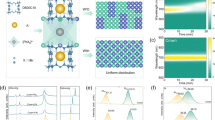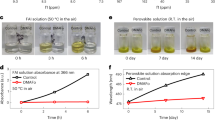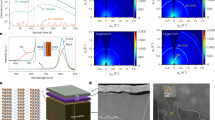Abstract
Formamidinium and caesium metal halide perovskites enable high efficiency in inverted perovskite solar cells, but uncontrolled crystallization limits their performance. Here we regulate the nucleation and growth of the perovskite through aromatic interactions between naphthalene ammonium salts and naphthalenesulfonates. The ammonium groups of the naphthalene ammonium salts occupy the formamidinium site, while the sulfonate groups of the naphthalenesulfonates coordinate with lead ions. Their naphthalene moieties form tight aromatic stacking adjacent to the [PbI6]4− octahedra. These interactions promote ordered out-of-plane crystallization along the (100) plane, enhancing defect passivation and carrier transport. We achieve a power conversion efficiency of 27.02% (certified 26.88%) for inverted solar cells. Encapsulated devices retain 98.2% of their initial efficiency after 2,000 h of maximum power point tracking under continuous illumination in ambient air. Furthermore, we demonstrate a certified steady-state efficiency of 23.18% for inverted mini-modules with an aperture area of 11.09 cm2 and a certified efficiency of 29.07% for all-perovskite tandem solar cells.
This is a preview of subscription content, access via your institution
Access options
Access Nature and 54 other Nature Portfolio journals
Get Nature+, our best-value online-access subscription
$32.99 / 30 days
cancel any time
Subscribe to this journal
Receive 12 digital issues and online access to articles
$119.00 per year
only $9.92 per issue
Buy this article
- Purchase on SpringerLink
- Instant access to full article PDF
Prices may be subject to local taxes which are calculated during checkout




Similar content being viewed by others
Data availability
The data that support the findings of this study are available within the Article and its Supplementary Information. Source data are provided with this paper.
References
Luo, X. et al. Recent advances of inverted perovskite solar cells. ACS Energy Lett. 9, 1487–1506 (2024).
Zhang, W. et al. Strategies for improving efficiency and stability of inverted perovskite solar cells. Adv. Mater. 36, 2311025 (2024).
Liang, Z. et al. Homogenizing out-of-plane cation composition in perovskite solar cells. Nature 624, 557–563 (2023).
Li, F. et al. Hydrogen-bond-bridged intermediate for perovskite solar cells with enhanced efficiency and stability. Nat. Photon. 17, 478–484 (2023).
Li, Z. et al. Stabilized hole-selective layer for high-performance inverted p-i-n perovskite solar cells. Science 382, 284–289 (2023).
Peng, W. et al. Reducing nonradiative recombination in perovskite solar cells with a porous insulator contact. Science 379, 683–690 (2023).
Liu, S. et al. Buried interface molecular hybrid for inverted perovskite solar cells. Nature 632, 536–542 (2024).
Jiang, Q. et al. Surface reaction for efficient and stable inverted perovskite solar cells. Nature 611, 278–283 (2022).
Zhang, S. et al. Minimizing buried interfacial defects for efficient inverted perovskite solar cells. Science 380, 404–409 (2023).
Liu, C. et al. Bimolecularly passivated interface enables efficient and stable inverted perovskite solar cells. Science 382, 810–815 (2023).
Chen, H. et al. Improved charge extraction in inverted perovskite solar cells with dual-site-binding ligands. Science 384, 189–193 (2024).
Shi, P. et al. Oriented nucleation in formamidinium perovskite for photovoltaics. Nature 620, 323–327 (2023).
Huang, Z. et al. Anion–π interactions suppress phase impurities in FAPbI3 solar cells. Nature 623, 531–537 (2023).
Park, J. et al. Controlled growth of perovskite layers with volatile alkylammonium chlorides. Nature 616, 724–730 (2023).
Yang, W. S. et al. High-performance photovoltaic perovskite layers fabricated through intramolecular exchange. Science 348, 1234–1237 (2015).
Kim, M. et al. Methylammonium chloride induces intermediate phase stabilization for efficient pPerovskite solar cells. Joule 3, 2179–2192 (2019).
Chen, S. et al. Stabilizing perovskite–substrate interfaces for high-performance perovskite modules. Science 373, 902–907 (2021).
Lin, L. et al. Hydrogen bonding in perovskite solar cells. Matter 7, 38–58 (2024).
Wu, Z. et al. Crystallization kinetics of hybrid perovskite solar cells. Angew. Chem. Int. Ed. 63, e202319170 (2024).
Bu, T. et al. Lead halide–templated crystallization of methylamine-free perovskite for efficient photovoltaic modules. Science 372, 1327–1332 (2021).
Jeong, J. et al. Pseudo-halide anion engineering for α-FAPbI3 perovskite solar cells. Nature 592, 381–385 (2021).
McMeekin, D. P. et al. Intermediate-phase engineering via dimethylammonium cation additive for stable perovskite solar cells. Nat. Mater. 22, 73–83 (2023).
Liu, S. et al. Triple-junction solar cells with cyanate in ultrawide-bandgap perovskites. Nature 628, 306–312 (2024).
Liang, Z. et al. Molecular sublimation enables 2D–3D transformation of orientational FAPbI3 perovskites. Nat. Synth. 4, 347–358 (2025).
Zheng, X. et al. Managing grains and interfaces via ligand anchoring enables 22.3%-efficiency inverted perovskite solar cells. Nat. Energy 5, 131–140 (2020).
Ma, C. et al. Photovoltaically top-performing perovskite crystal facets. Joule 6, 2626–2643 (2022).
Liu, Z. et al. All-perovskite tandem solar cells achieving >29% efficiency with improved (100) orientation in wide-bandgap perovskites. Nat. Mater. 24, 252–259 (2025).
Xiang, W. et al. Intermediate phase engineering of halide perovskites for photovoltaics. Joule 6, 315–339 (2022).
Du, S. et al. Inhibiting perovskite decomposition by a creeper-inspired strategy enables efficient and stable perovskite solar cells. Nat. Commun. 15, 5223 (2024).
Yang, T. et al. One-stone-for-two-birds strategy to attain beyond 25% perovskite solar cells. Nat. Commun. 14, 839 (2023).
Wang, J. et al. Bimolecular crystallization modulation boosts the efficiency and stability of methylammonium-free tin–lead perovskite and all-perovskite tandem solar cells. Adv. Energy Mater. 14, 2402171 (2024).
Caprioglio, P. et al. On the relation between the open-circuit voltage and quasi-Fermi level splitting in efficient perovskite solar cells. Adv. Energy Mater. 9, 1901631 (2019).
Luo, D. et al. Enhanced photovoltage for inverted planar heterojunction perovskite solar cells. Science 360, 1442–1446 (2018).
Zhou, Q. et al. Annual research review of perovskite solar cells in 2023. Mater. Futur. 3, 022102 (2024).
Pei, F. et al. A binary 2D perovskite passivation for efficient and stable perovskite/silicon tandem solar cells. Nat. Commun. 15, 7024 (2024).
Kresse, G. & Furthmüller, J. Efficient iterative schemes for ab initio total-energy calculations using a plane-wave basis set. Phys. Rev. B 54, 11169–11186 (1996).
Zhou, Q. et al. Multifunctional chemical bridge and defect passivation for highly efficient inverted perovskite solar cells. ACS Energy Lett. 6, 1596–1606 (2021).
Chen, R. et al. Reduction of bulk and surface defects in inverted methylammonium- and bromide-free formamidinium perovskite solar cells. Nat. Energy 8, 839–849 (2023).
Li, H. et al. 2D/3D heterojunction engineering at the buried interface towards high-performance inverted methylammonium-free perovskite solar cells. Nat. Energy 8, 946–955 (2023).
Zhu, P. et al. Aqueous synthesis of perovskite precursors for highly efficient perovskite solar cells. Science 383, 524–531 (2024).
Tan, Q. et al. Inverted perovskite solar cells using dimethylacridine-based dopants. Nature 620, 545–551 (2023).
Zhu, H. et al. In situ energetics modulation enables high-efficiency and stable inverted perovskite solar cells. Nat. Photon. 19, 28–35 (2024).
Gao, Z.-W. et al. Eutectic molecule ligand stabilizes photoactive black phase perovskite. Nat. Photon. 19, 258–263 (2025).
Li, S. et al. Coherent growth of high-Miller-index facets enhances perovskite solar cells. Nature 635, 874–881 (2024).
Liu, C. et al. Two-dimensional perovskitoids enhance stability in perovskite solar cells. Nature 633, 359–364 (2024).
Li, S. et al. High-efficiency and thermally stable FACsPbI3 perovskite photovoltaics. Nature 635, 82–88 (2024).
Acknowledgements
W.C. acknowledges the financial support from the Ministry of Science and Technology of China (2021YFB3800104), the National Natural Science Foundation of China (W2412077 and U20A20252) and the Innovation Project of Optics Valley Laboratory (OVL2025YZ004). Z.L. acknowledges the National Natural Science Foundation of China (52473301), the Young Elite Scientists Sponsorship Program by CAST, the Natural Science Foundation of Hubei Province (2022CFA093), the Self-determined and Innovative Research Funds of HUST (2020kfyXJJS008), the Fundamental Research Support Program of Huazhong University of Science and Technology (2025BRB016) and the State Key Laboratory of Alternate Electrical Power System with Renewable Energy Sources (LAPS25001). Y.L. acknowledges the National Key Research and Development Program of China (2024YFF0507802 and 2024YFE0211400), the National Natural Science Foundation of China (12422401, 12074016 and 12274009) and the Excellent Youth Fund of Beijing Natural Science Foundation (JQ24009). Q.Z. acknowledges the China Postdoctoral Science Foundation (2024M751002) and the Postdoctoral Fellowship Program of China Postdoctoral Science Foundation (GZC20240528). J.W. acknowledges the Fundamental Research Funds for the Central Universities, HUST (2023JYCXJJ041). We thank the Analytical and Testing Center of HUST for the support of facilities for sample measurements. We thank the staff of the BL17B beamline (https://cstr.cn/31129.02.NFPS.BL17B) at the National Facility for Protein Science in Shanghai (https://cstr.cn/31129.02.NFPS), Shanghai Advanced Research Institute, Chinese Academy of Sciences, for their technical support in GIWAXS data collection and analysis. We are grateful for the support of the computing resources provided by the Center for Computational Science and Engineering at Southern University of Science and Technology.
Author information
Authors and Affiliations
Contributions
W.C., Z.L., Y.L. and Q.Z. conceived the project and designed the experiments. W.C. and Z.L. directed and supervised the project. Q.Z., J.W. and R.C. fabricated the devices. Q.Z., J.W., R.C., T.M., S.L., H.Z., Z.T., C.S. and X. Liu performed the material and device characterizations. G.H., M.S. and Y.L. performed the TEM measurements. T.M. performed the in situ GIWAXS measurements. E.X. and Y.S. performed the AFM-IR measurements. Q.W., Y.C. and Q.C. performed the temperature-dependent dark conductivity measurements. X. Lei and J.L. performed the density functional theory calculations and theoretical analysis. W.C., Z.L., Y.L. and Q.Z. co-wrote the paper. All authors discussed the results and commented on the written manuscript.
Corresponding authors
Ethics declarations
Competing interests
The authors declare no competing interests.
Peer review
Peer review information
Nature Energy thanks Yu Duan, Seok Joon Kwon and the other, anonymous, reviewer(s) for their contribution to the peer review of this work.
Additional information
Publisher’s note Springer Nature remains neutral with regard to jurisdictional claims in published maps and institutional affiliations.
Supplementary information
Supplementary Information
Supplementary Figs. 1–60, Notes 1–7 and Tables 1–6.
Supplementary Data 1
Source data for Supplementary Figs. 23d, 44, 45, 53, 54, 55 and 58.
Source data
Source Data Fig. 4
Source data for Fig. 4a,b,d–f.
Rights and permissions
Springer Nature or its licensor (e.g. a society or other partner) holds exclusive rights to this article under a publishing agreement with the author(s) or other rightsholder(s); author self-archiving of the accepted manuscript version of this article is solely governed by the terms of such publishing agreement and applicable law.
About this article
Cite this article
Zhou, Q., Huang, G., Wang, J. et al. Aromatic interaction-driven out-of-plane orientation for inverted perovskite solar cells with improved efficiency. Nat Energy (2025). https://doi.org/10.1038/s41560-025-01882-x
Received:
Accepted:
Published:
DOI: https://doi.org/10.1038/s41560-025-01882-x



